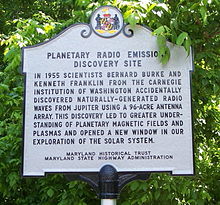Jupiter bursts
Jupiter bursts (also DAM for decametric radio emission ) are natural radio signals in the shortwave range that emanate from the planet Jupiter .
The signals were discovered in 1955 by the two American astronomers Kenneth Franklin and Bernard Flood Burke .
The strongest Jupiter bursts occur when volcanic activity on its moon Io hurls gas into Jupiter's magnetosphere . This creates plasma waves which, depending on the constellation, can be received on earth. The exact mechanism of its formation is still unknown.
There are L bursts (long) and S bursts (short). L bursts sound like surf waves and S bursts like the flutter of a flag in the wind.
The signals are easy to receive due to their frequency and high signal strength. They are therefore particularly suitable for amateur observations and school projects, for example with the hardware and software provided by the Radio JOVE project of the American aerospace authority NASA .
literature
- Wilhelm Raith (Ed.): Bergmann / Schaefer: Textbook of Experimental Physics Volume 7. Earth and Planets. De Gruyter, Berlin 2001, pp. 576-580.
- Jim Kennedy: 15 meter signals from Jupiter. In: 73 Magazine, August 1971, pp. 66-72.
- Millyn Moore: Reception of radio-frequency emissions from Jupiter. In: QST, September 1971, p. 48.
- Jon Wallace, Richard Flagg: Amateur radio astronomy projects - radio signals from Jupiter. In: QEX, May / June 2010, p. 33 ff.
Web links
- Radio JOVE Project (NASA)
Individual evidence
- ^ BF Burke, KL Franklin: Observations of a variable radio source associated with the planet Jupiter. In: J. Geophys. Res., 1955 (60), 213-217. ( online )
- ^ Melvyn L. Goldstein, CK Goertz: Theories of radio emissions and plasma waves. In: AJ Dessler (Ed.): Physics of the Jovian magnetosphere. Cambridge University Press, Cambridge UK 2002, pp. 317-352, p. 317.
